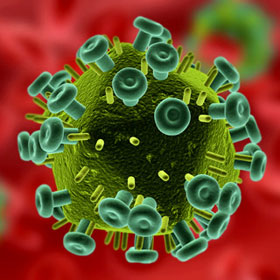New method to reduce the risk of HIV infection in semen
Scientists at the Gladstone, San-Fransico Institute of Virus and Immunology Institute, published a new study on surfen substances that is capable of reducing HIV transmission through sexual pathways.
Scientists at Gladstone's Virus and Immunology Institute (GIVI) have discovered a new substance capable of limiting the transmission of HIV, called "surfen", weakening the activity of the The ability to enhance this virus infection in semen.
Surfen can be used as a supplement for HIV disinfectants, thus significantly reducing the transmission of HIV through sexual pathways.

Photo illustrating HIV virus.
Dr. Nadian Roan, a senior fellow at the GIVI laboratory, discovered surfen - a small molecule that limits the activity of a type of polyacryl molecule called HSPG - found see on the cell surface. This discovery is published in the journal Biological Chemistry.
Greene, a partner of Dr. Roan, said: 'We are working on SEVI, a natural occurrence factor expressed in semen that can help HIV easily infect thousands of times. Understanding clearly about surfen, who prevented SEVI, could allow us to lower the rate of HIV transmission.
SEVI is a product of prostate phosphate acid, a protein in semen. Under certain conditions, SEVI can increase HIV infection by 100,000 times by making it easy to attach to target cells. Much of HIV infection is the result of sexual intercourse (in the process, semen is the means of transporting HIV).
SEVI has a clear effect on HIV transmission rates, involving SEVI's association with both target cells and the HIV-1 infection, but does not break down SEVI fibers.
Greene explains: 'Because SEVI has the ability to enhance HIV infection, a candidate for limiting it - surfen, can increase the effectiveness of prevention as an adjuvant to reduce HIV. " .
Dr. Roan said: 'SEVI has 8 basic amino acids that make it much positive. In the previous study, we showed that SEVI's ability to increase positive charge-dependent infection has an effect on the negative charge group at the target cell's HSPG.
Scientists expect an opponent of HSPG to interfere with SEVI's attachment to targeted viruses and cells. They focused on surfen - first described in 1938 and reported to be anti-inflammatory and resistant to bacterial activity.
The team found that surfen limited the enhancement of HIV-1 infection by SEVI clean or semen. Further, they demonstrate surfen's intervention to the connection of SEVI to both target cells and HIV-1 infections.
- Cycling 5 hours a week can reduce sperm in men
- Normal indicators when evaluating a semen test
- Sperm luteum - complication of infection
- Using medicine when being bitten by animals, insects burn
- Take 1 tablet / day, less afraid of HIV infection ...
- Husband and wife infected with HIV: Can still have healthy children
- The main semen is a virus reservoir.
- Biological glue gun for wound healing
- New testing method reduces the risk of multiple births
- Breast-feeding: Healthy baby, mother reduce arthritis
- Eating lots of fat is considered to reduce sperm quality
- How to prevent flu infection on aircraft
 Why do potatoes have eyes?
Why do potatoes have eyes? 'Tragedy' the world's largest carnivorous life: Death becomes ... public toilet
'Tragedy' the world's largest carnivorous life: Death becomes ... public toilet Tomatoes were once considered 'poisonous' for 200 years
Tomatoes were once considered 'poisonous' for 200 years Detecting microscopic parasites on human face
Detecting microscopic parasites on human face